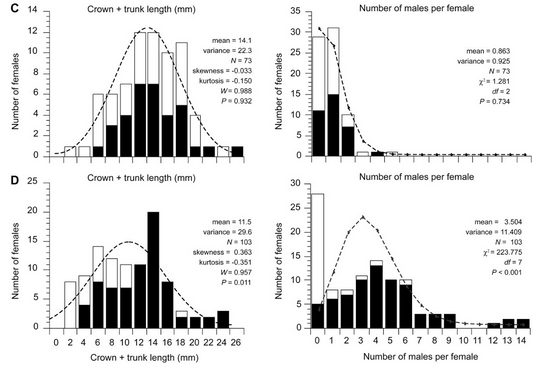Environmentally Determined Sex
in Marine Worms
Biology 342
Fall 2014
Mical Yohannes and Patrick Shan
Reed College
Ontogeny
Ontogeny is the developmental history of an organism that details the formation of a behavior.
Environmental Pressures Shape the Growth and Maturation of these Annelids
Both Bonellia viridis and Osedax roseus have ontogeny dependent on environmental conditions. Bonellia larvae are initially undifferentiated yet become female when residing on the ocean floor or become male when attached to females. Osedax sex determination is also dependent on environment as larvae hatched near whale bones become females while those hatched away from whale bones become males. In both cases, the microscopic adult males reside inside their much larger adult female hosts to survive and fertilize the eggs.
Bonellia viridis
Sexual identity and ontogeny in Bonellia viridis is dependent on environmental exposure and contact with adult members of their species. Bonellia hatch as swimming undifferentiated larvae that search for pheromones produced by adult females. Larvae that fail to find adult females reside on the ocean floor and become females. These females become sexually mature in 2 years and use their probosci to gather both mates and food. Using their proboscis, a female captures free-floating larvae and transports them into its uterus where they are differentiated into males when exposed to bonellin. The males subsequently form symbiotic relationships with the females, gaining food and protection in exchange for fertilizing the eggs.
Osedax roseus
Sex Determination by Food Presence
During the larval stage, Osedax sex is determined by the presence of a food source. Undifferentiated larvae that hatched near whale bones devoid of colonies become females. These females mature quickly yet stop growing as adults to focus on reproduction and becoming hosts for males. In contrast, larvae that hatched away from bones remain as undifferentiated larvae unti lthey come into contact with female hosts that turn them into males.

Figure 1. Adult body legnth and male harem size in mature osedax females. At 4 (C) and 5 (D) months after initial skeletal colonization, females show increased harem size and reduced growth rate. As females mature and grow older, they show reduced growth rates with average lengths of 11.5 to 14.1 mm . Furthermore, mature females, particularly those greater than 12 mm long, are more likely to host males and have oviducts full of developed eggs (shown in graph as black) dmales (show in graph as black). In addition, the average number of males per individual female host increased from 1 to 4 males within the 1 month time span.
Females: Settle First and Grow Up Fast
The first undifferentiated larvae that hatched from eggs near whale skeletons are sexually differentiated into females. These juvenile femalesare have empty oviducts and do not host males. After 3 months though, mature females begin to host males and produce eggs. 7 months after initial colonization, 71.8% of all females in a population are producing eggs. Furthermore, most mature individual females show decreased growth and host approximately 4 males. The females' ontogeny allow them to quickly mature through extracting nutrient yet reduceds adult growth to divert individual resources towards becoming stable hosts and reproductive partners.
Males: Driven by Established Females
In contrast, the males have different developmental patterns. Eggs that are hatched away from whale bones become free-floating undifferentiated larvae. These larvae locate females using pheremone signaling and attach themselves inside the adult females. These larvae are subsequently differentiated into male adults that reside inside the female lumen, fertilizing the eggs in exchange for nutrition.